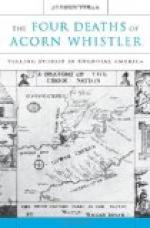Sir Rennell Rodd recalled that at a breakfast Waldo Story gave at Dieu-donné’s in Paris there was a great company, including Whistler. Every one there was by the way of having written a book or painted a picture, or having in some way outraged the Philistine, with the exception of one young gentleman whose raison d’être was not so apparent as his high collar and the glory of his attire. He nevertheless intruded boldly into the talk and laid down his opinions very flatly. He even went so far as to combat some dictum of the master’s, whereat that gentleman adjusted his glasses and, looking pleasantly at the youth, queried:
“And whose son are you?”
When Dorothy Menpes was a babe in the cradle a white feather lay across her infant brow. The sight pleased Whistler. “That child is going to develop into something great,” he prophesied, “for see, she begins with a feather, just like me.”
* * * * *
In the last two years of his life Mr. Whistler’s disputes grew less frequent and his public flashes were few. The Morning Post of London, however, provoked an admirable specimen of his best style, which it printed under date of August 6th, 1902. In its “Art and Artists” column the paper had made the following statement:
“Mr. Whistler is so young in spirit that his friends must have read with surprise the Dutch physician’s announcement that the present illness is due to ‘advanced age.’ In England sixty-seven is not exactly regarded as ‘advanced age,’ but even for the gay ‘butterfly’ time does not stand still, and some who are unacquainted with the details of Mr. Whistler’s career, though they know his work well, will be surprised to learn that he was exhibiting at the Academy forty-three years ago. His contributions to the exhibition of 1859 were ‘Two Etchings from Nature,’ and at intervals during the following fourteen or fifteen years Mr. Whistler was represented at the Academy by a number of works, both paintings and etchings. In 1863 his contributions numbered seven in all, and in 1865 four. Among his Academy pictures of 1865 was the famous ‘Little White Girl,’ the painting that attracted so much attention at the Paris Exhibition of 1900. This picture—rejected at the Salon of 1863—was inspired, though the fact seems to have been forgotten of late, by the following lines of Swinburne:
Come snow, come wind or thunder
High up in air,
I watch my face and wonder
At my bright hair, etc.”
Under date of August 3d Mr. Whistler sent from The Hague this brisk reply:
I feel it no indiscretion to speak of my “convalescence,” since you have given it official existence.
May I, therefore, acknowledge the tender little glow of health induced by reading, as I sat here in the morning sun, the flattering attention paid me by your gentleman of the ready wreath and quick biography?




